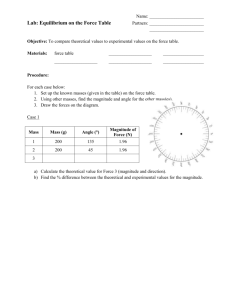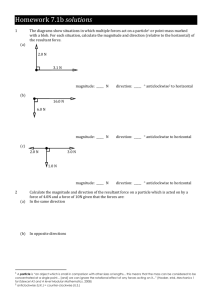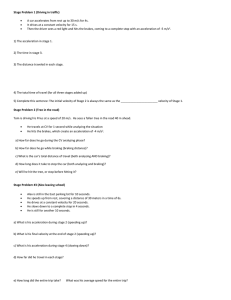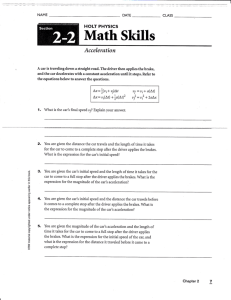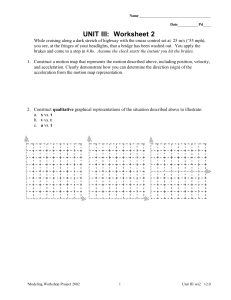M2 Exam PowerPoint - Teachnet UK-home
advertisement
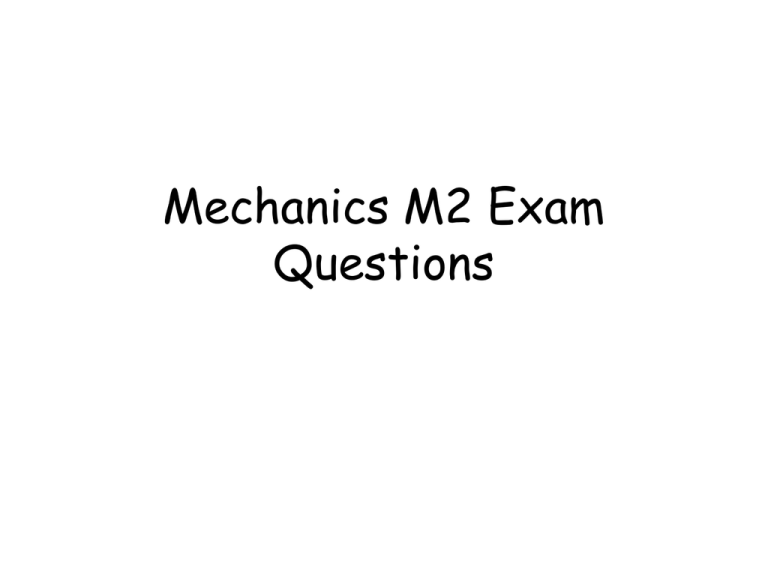
Mechanics M2 Exam Questions Click to go straight to a particular topic Moments Centre of Mass Work Energy Power Kinematics (Vectors) Work Energy Power 2 Collisions Projectiles Question 1 • A uniform rod AB, of length 8a and weight W, is free to rotate in a vertical plane about a smooth pivot at A. One end of a light inextensible string is attached to B. The other end is attached to point C which is vertically above A, with AC = 6a. The rod is in equilibrium with AB horizontal, as shown below. C 6a B A 8a (a) By taking moments about A, or otherwise, show that the C tension in the string is 5/6W. (4) Add the forces to diagram. By Pythag CB = 10a Taking moments about A 6a X Y T B A 8a 4aW=8aTSinB S in B 6a 3 10a 5 4aW 8aT 5 T W 6 3 5 W (b) Calculate the magnitude of the horizontal component of the force exerted by the pivot on the rod. C (3) Add the forces to diagram. Resolving forces horizontally. X = TCosB 8a 4 CosB 10a 5 Therefore 6a X 5 T W 6 2 X W 3 Y T B A 8a W Question 2 Figure 2 shows a metal plate that is made by removing a circle of centre O and radius 3 cm from a uniform rectangular lamina ABCD, where AB = 20 cm and BC = 10 cm. The point O is 5 cm from both AB and CD and is 6 cm from AD. 20 cm A B 5 cm 3 cm 10 cm O 6 cm D C (a) Calculate, to 3 significant figures, the distance of the centre of mass of the plate from AD. (5) Centre of mass will lie on mirror line. 20 cm A B Circle Rectangle Plate Masses 9∏ 200 2009∏ 3 cm Centre of mass 6 10 x O 9 6 (200 9 )x 200 10 X = 10.7cm 5 cm 10 cm 6 cm D C The plate is freely suspended from A and hangs in equilibrium. (b) Calculate, to the nearest degree, the angle between AB and the vertical. (3) G will be directly below A. B A G Therefore angle GAB is given by: D 5 Tan 1 25 10.7 C Question 3 A small package P is modelled as a particle of mass 0.6 kg. The package slides down a rough plane from a point S to a point T, where ST = 12 m. The plane is inclined at an angle of 30 to the horizontal and ST is a line of greatest slope of the plane, as shown in Figure 3. The speed of P at S is 10 m s–1 and the speed of P at T is 9 m s–1. S P 12 m T 30 Calculate (a) the total loss of energy of P in moving from S to T, (4) KE at S = ½ × 0.6 × 100 = 30Js S KE at T = ½ × 0.6 × 81 = 24.3Js 12 m KE lost = 5.7Js PE Lost = mgh = 0.6 × 9.8 × 12Sin30º = 35.28Js Total loss of energy = 41.0Js P T 30 Calculate (b) the coefficient of friction between P and the plane. (5) Add forces to diagram, and resolve perpendicular to the plane. R = 0.6 × 9.8 × Sin30º = 5.09 Using F = μR F = μ × 5.09 Work done against F = loss of energy μ × 5.09 × 12 = 40.98 μ = 0.67 R F S P 12 m T 30 Question 4 A particle P of mass 0.4 kg is moving under the action of a single force F newtons. At time t seconds, the velocity of P, v m s–1, is given by v = (6t + 4)i + (t2 + 3t)j. When t = 0, P is at the point with position vector (–3i + 4j) m. (a) Calculate the magnitude of F when t = 4. (4) Using F = ma and the fact that the acceleration is differential of the velocity vector. v = (6t + 4)i + (t2 + 3t)j. a = 6i + (2t + 3)j When t = 4, a = 6i + 11j therefore F = 0.4 × (6i + 11j) Magnitude of F =√(2.42 + 4.42) = 5.0 When t = 4, P is at the point S. (b) Calculate the distance OS. (5) The position vector is found by integrating the velocity vector r = i (6t + 4)dt + j (t2 + 3t)dt t3 3 2 r=(3t + 4t)i+( + t )j+C1i C2 j 3 2 2 When t = 0, P has position vector (-3i + 4j). t3 3 2 r=(3t + 4t-3)i+( + t +4)j 3 2 2 When t = 4, r = 61i +49⅓j 2 2 1 OS= 61 49 78m 3 Question 5 A car of mass 1000 kg is towing a trailer of mass 1500 kg along a straight horizontal road. The tow-bar joining the car to the trailer is modelled as a light rod parallel to the road. The total resistance to motion of the car is modelled as having constant magnitude 750 N. The total resistance to motion of the trailer is modelled as of magnitude R newtons, where R is a constant. When the engine of the car is working at a rate of 50 kW, the car and the trailer travel at a constant speed of 25 m s–1. (a) Show that R = 1250. (3) RN 750N F 1500kg T T 1000kg Power = Force × Velocity Force = (50000/25) = 2000N Constant velocity implies that F = 750 + R Therefore R = 1250N When travelling at 25 m s–1 the driver of the car disengages the engine and applies the brakes. The brakes provide a constant braking force of magnitude 1500 N to the car. The resisting forces of magnitude 750 N and 1250 N are assumed to remain unchanged. Calculate (b) the deceleration of the car while braking, 1250N (3) 750N Why have the arrows changed? 1500kg T T 1000kg 1500N Using F = ma 2000N + 1500N = 2500a Therefore a = 1.4ms-2 When travelling at 25 m s–1 the driver of the car disengages the engine and applies the brakes. The brakes provide a constant braking force of magnitude 1500 N to the car. The resisting forces of magnitude 750 N and 1250 N are assumed to remain unchanged. Calculate (c) the thrust in the tow-bar while braking, 1250N 1500kg T 750N T 1000kg 1500N Equation of motion of car is Thrust = 850N T – 750 – 1500N = 1000 × -1.4 (2) When travelling at 25 m s–1 the driver of the car disengages the engine and applies the brakes. The brakes provide a constant braking force of magnitude 1500 N to the car. The resisting forces of magnitude 750 N and 1250 N are assumed to remain unchanged. Calculate (d) the work done, in kJ, by the braking force in bringing the car and the trailer to rest. (4) Using v2 u2 2as u = 25ms-1 a = -1.4ms-2 v = 0, therefore s =223.2m Work done = force x distance Work done = 1500 x 223.2 = 335KJ When travelling at 25 m s–1 the driver of the car disengages the engine and applies the brakes. The brakes provide a constant braking force of magnitude 1500 N to the car. The resisting forces of magnitude 750 N and 1250 N are assumed to remain unchanged. Calculate (e) Suggest how the modelling assumption that the resistances to motion are constant could be refined to be more realistic. (1) Resistance varies with respect to speed. Question 6 A particle P of mass 3m is moving with speed 2u in a straight line on a smooth horizontal table. The particle P collides with a particle Q of mass 2m moving with speed u in the opposite direction to P. The coefficient of restitution between P and Q is e. (a) Show that the speed of Q after the collision is 0.2u(9e + 4). Remember to always draw a diagram 2u Before P 3m v1 u Q 2m After P By conservation of momentum 3m v2 Q 2m 6mu – 2mu = 3mv1 + 2mv2 4u = 3v1 + 2v2 (1) Coefficient of restitution = speed of separation/speed of approach Therefore Sub (2) into (1) 3eu = v2 - v1 and 4u = 3v2 - 9eu +2v2 v1 = v2 - 3eu (2) Hence v2 = 0.2u(9e+ 4) As a result of the collision, the direction of motion of P is reversed. (b) Find the range of possible values of e. From a) v2 = 0.2u(9e+ 4) Therefore v1 = 0.2u(9e+4) - 3eu and Hence v1 = 0.4u(2 – 3e) But v1<0 Therefore (2 – 3e) < 0 So e>(2/3) and e<1 v1 = v2 - 3eu (5) Given that the magnitude of the impulse of P on Q is 6.4mu, (c) find the value of e. (4) Impulse = change in momentum 6.4mu = 2m(0.2u(9e+4) +u) 6.4u = 3.6eu + 1.6u + 2u 2.8 = 3.6e e=7/9 Question 7 A particle P is projected from a point A with speed 32 m s–1 at an angle of elevation , where sin = 3/5 The point O is on horizontal ground, with O vertically below A and OA = 20 m. The particle P moves freely under gravity and passes through a point B, which is 16 m above ground, before reaching the ground at the point C, as shown above. Calculate (a) the time of the flight from A to C, Vertical component of velocity is vsinα = 19.2ms-1 Using 1 s ut at2 2 Therefore t = 4.77sec With s = -20, u = 19.2, a = -9.8 (5) Calculate (b) the distance OC, Horizontal component of velocity = vcosα =25.6ms-1 Distance = speed ×time = 25.6 × 4.77 = 122m (3) Calculate (c) the speed of P at B, Using v2 u2 2as (4) Where s = -4, a = -9.8 and u = 19.2 Vertical component of velocity = 21.14ms-1 Horizontal component remains constant = 25.6ms-1 Therefore by Pythagoras speed = 33.2ms-1 Calculate (d) the angle that the velocity of P at B makes with the horizontal. (3) 21.14 Tan 25.6 39.6


